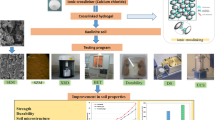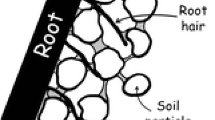Abstract
The transfer of nutrients from the soil to root cells is mediated by a mucilaginous interface composed predominantly of polysaccharides which are characterized by a fibrillar structure. A network of Ca-polygalacturonate was formed on garlic roots. This artificial network was compared with naturally formed mucilage structures using transmission (TEM) and scanning electron microscopy (SEM). The synthetic Ca-polygalacturonate could serve as a model for the study of the ionic transfer in the soil-root interface.
Similar content being viewed by others
References
Deiana, S, Erre, L, Micera, G, Piu, P and Gessa, C 1980 Coordination of transition-metal ions by polygalacturonic acid: A spectroscopic study. Inorg. Chim. Acta 46, 249–253.
Deiana, S, Micera, G, Muggiolu, G, Gessa, C and Pusino, A 1983 Interaction of transition metal ions with polygalacturonic acid: A potentiometric study. Colloids Surfaces 6, 17–25.
Deiana, S, Gessa, C, Solinas, V, Piu, P and Seeber, R 1989a Complexing and redox properties of the system D-galacturonic acid-iron (III). J. Inorg. Biochem. 35, 107–113.
Deiana, S, Gessa, C, Solinas, V, Piu, P and Seeber, R 1989b Analytical study of the interaction of D-galacturonic acid with iron (III) and iron (II) in solution and with iron(III)-bentonite. Anal. Chim. Acta 226, 315–322.
Deiana, S, Gessa, C, Piu, P and Seeber, R 1990a Iron (III) reduction by D-galacturonic acid. Part II: Influence of uranil (VI), lead (II), nickel (II), and cadmium complexes formation. J. Inorg. Biochem. 40, 301–307.
Deiana S, Gessa C, Piu P and Seeber R 1991 Iron (III) reduction by D-galacturonic acid. Part III: Influence of the presence of additional metal ions and of 2-amino-2-deoxy-D-gluconic acid. J. Chem. Soc. Dalton Trans. 1237–1241.
Döbereiner, J 1974 Nitrogen-fixing bacteria in the rhizosphere. In The Biology of Nitrogen Fixation. Ed. A Quispel. Elsevier/North Holland, Biomedical Press, Amsterdam, New York.
Floyd, R A and Ohlrogge, A J 1970 Gel formation on nodal root surfaces of Zea mays. I. Investigation on the gel composition. Plant and Soil 33, 341–343.
Gessa, C, DeCherchi, M L, Dessi, A, Deiana, S and Micera, G 1983a The reduction of Fe(III) to Fe(II) and V(V) to V(IV) by polygalacturonic acid: A reduction and complexation mechanism of biochemical significance. Inorg. Chim. Acta 80, L53–L55.
Gessa, C, Deiana, S and Marceddu, S 1989 Fibrillar structure of Ca-polygalacruronate as a model for soil-root interface: Metal ion absorption and its effect on the free space volume of the system. In Plant Membrane Transport: The Current Position. Eds. I Dainty, M I De Michelis, E Marrè and F Rasi-Caldogno. pp 615–616. Elsevier Publishers, Amsterdam.
Gessa, C and Deiana, S 1990a Fibrillar structure of Capolygalacturonate as a model for a soil-root interface. I. A hypothesis on the arrangement of the polymeric chains inside the fibrils. Plant and Soil 129, 211–217.
Gessa C, Deiana S, Marchetti M and Usai M 1990b Complexation and redox reactions in the soil-root interface. Proc. ‘Stress Ambientali nei Vegetali’, Roma.
Gessa, C and Deiana, S 1990c Transfer of metal ions in the soil-root interface: Influence of copper(II) on the stability of the fibrils. Giornale Botanico Italiano 124, 191–193.
Guckert, A, Breisch, H and Reisinger, O 1975 Interface soilracine: Etude au microscope electronique des relations mucigel-argile-microorganisme. Soil Biol. Biochem. 7, 241–250.
Jenny, H and Grossenbacher, K 1963 Root-soil boundary zones as seen in the electron microscope. Soil Sci. Soc. Am. Proc. 27, 273–277.
Leppard, G G 1974 Rhizoplane fibrils in wheat: Demonstration and derivation. Science 185, 1066–1067.
Leppard, G G and Ramamoorthy, S 1975 The aggregation of wheat rhizoplane fibrils and the accumulation of soil-bound cations. Can. J. Bot. 53, 1729–1735.
Morel, J L, Mench, M and Guckert, A 1986 Measurements of Pb(II), Cu(II) and Cd(II) binding with mucilage exudate from maize (Zea Mays L.) roots. Biol. Fertil. Soils 2, 29–34.
Ramamoorthy, S and Leppard, G G 1977 Fibrillar pectin and contact cation exchange at the root surface. J. Theor. Biol. 66, 527–540.
Paull, R E, Johnson, C M and Jones, R L 1975 Studies on the secretion of maize root cap slime. I. Some properties of the secreted polymer. Plant Physiol. 56, 300–306.
Wright, K and Northcote, D H 1976 The relationship of root-cap slimes to pectins. Biochem. J. 139, 525–534.
Author information
Authors and Affiliations
Rights and permissions
About this article
Cite this article
Gessa, C., Deiana, S. Ca-polygalacturonate as a model for a soil-root interface. Plant Soil 140, 1–13 (1992). https://doi.org/10.1007/BF00012801
Received:
Issue Date:
DOI: https://doi.org/10.1007/BF00012801




